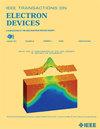22nm fd - soi中的高电阻率衬底-第一部分:宽带建模及其对射频损耗的影响
IF 3.2
2区 工程技术
Q2 ENGINEERING, ELECTRICAL & ELECTRONIC
引用次数: 0
摘要
本文研究了硅衬底的体积和界面电阻率如何影响22nm完全耗尽绝缘体上硅(FD-SOI)技术制造的器件的射频性能。为了研究这一点,使用GlobalFoundries的22FDX(注册商标)工艺在一系列基板上设计和制造共面波导(cpw),从标准的10- $\Omega $ cm硅晶圆到高电阻率(HR) 620- $\Omega $ cm晶圆。此外,还探讨了各种硅界面条件,介绍了界面电阻率和体电阻率变化的工艺变化。为了实现高界面电阻率,在界面上实现了一系列p-n结,这些结被证明可以大大降低射频损耗。从CPW线测量数据中,提取了所有六种考虑的衬底变化的界面和体电阻率值。这些特性的提取可以对所有衬底堆叠中的材料进行建模,并允许对各种形状、功能和特征尺寸的各种RF布局进行电磁(EM)模拟,例如螺旋电感器和毫米波单极双掷(SPDT)开关。这样的模拟与使用校准的材料堆描述的测量数据很好地相关。这项工作证明了衬底的体积和界面特性对这些器件的损耗和质量的影响,并强调了有效的界面钝化技术和适当建模的必要性。本文章由计算机程序翻译,如有差异,请以英文原文为准。
High-Resistivity Substrates in 22-nm FD-SOI—Part I: Wideband Modeling and Impact on RF Losses
This article examines how the bulk and interface resistivity of silicon substrates influence the RF performance of devices fabricated in 22-nm fully depleted silicon-on-insulator (FD-SOI) technology. To investigate this, coplanar waveguides (CPWs) were designed and manufactured using GlobalFoundries’ 22FDX (Registered trademark) process on a range of substrates, from standard 10- $\Omega $ cm silicon wafers to high-resistivity (HR) 620- $\Omega $ cm wafers. In addition, various silicon-interface conditions were explored, introducing process variations in interface resistivity alongside changes in bulk resistivity. To achieve high interfacial resistivity, a series of p-n junctions were implemented at the interface, and these are proven to drastically reduce RF losses. From the CPW line measurement data, interface and bulk resistivity values were extracted for all six considered substrate variations. The extraction of these properties enables modeling of the materials present in all substrate stacks and permits electromagnetic (EM) simulations of various RF layouts of various shapes, functions and characteristic dimensions, such as spiral inductors and mm-wave single-pole double-throw (SPDT) switches. Such simulations are shown to correlate well to the measured data using the calibrated material stack description. This work demonstrates the impact of the substrate’s bulk and interface properties on the losses and quality of these devices and highlights the necessity for an effective interface passivation technique and appropriate modeling.
求助全文
通过发布文献求助,成功后即可免费获取论文全文。
去求助
来源期刊

IEEE Transactions on Electron Devices
工程技术-工程:电子与电气
CiteScore
5.80
自引率
16.10%
发文量
937
审稿时长
3.8 months
期刊介绍:
IEEE Transactions on Electron Devices publishes original and significant contributions relating to the theory, modeling, design, performance and reliability of electron and ion integrated circuit devices and interconnects, involving insulators, metals, organic materials, micro-plasmas, semiconductors, quantum-effect structures, vacuum devices, and emerging materials with applications in bioelectronics, biomedical electronics, computation, communications, displays, microelectromechanics, imaging, micro-actuators, nanoelectronics, optoelectronics, photovoltaics, power ICs and micro-sensors. Tutorial and review papers on these subjects are also published and occasional special issues appear to present a collection of papers which treat particular areas in more depth and breadth.
 求助内容:
求助内容: 应助结果提醒方式:
应助结果提醒方式:


